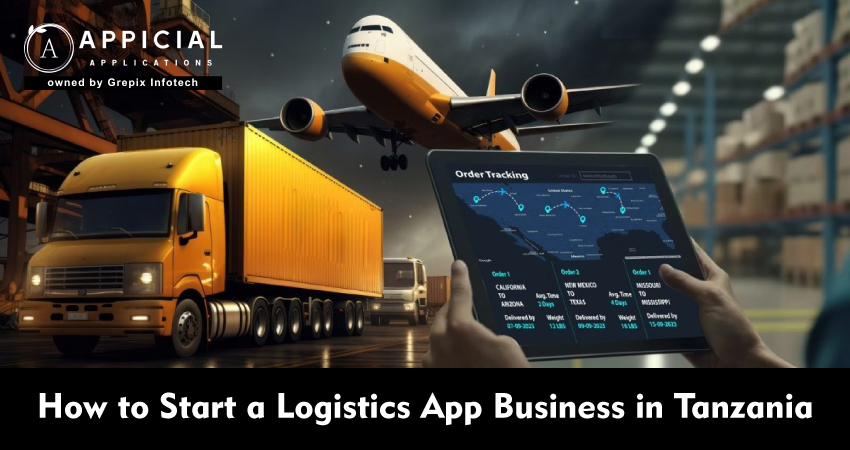
How to Start a Logistics App Business in Tanzania
Let’s be honest!
Getting goods from point A to point B in Tanzania is not easy. There are delays, missed drop-offs, and a lot of guesswork. Many businesses lose time and money simply because they don’t have the tools to manage their deliveries properly.
But the need for logistics isn’t going anywhere. If anything, it's growing. More small businesses are popping up. E-commerce is picking up pace. Even local vendors are trying to deliver directly to customers.
That’s why now is the time to build a logistics app that works, one that understands the local reality, runs well on basic smartphones, and actually makes life easier.
This guide will show you what that looks like.
Whether you're starting from scratch or already have a delivery business you want to digitize, there's something in here for you.
Let’s dive in!
Tanzania continues to grow swiftly, which means there is a huge demand for more intelligent logistics. Delivery is a problem for companies of all sizes, whether they are wholesalers in Kariakoo or tiny food vendors in Arusha. In actuality, a large number of people continue to track shipments using manual systems, spreadsheets, or WhatsApp messages. The gap is clear, and this is where logistics apps can make a huge impact. This blog walks you through how to start a logistics app business in Tanzania, step by step. We cover what features matter, the cost of development, and how to approach both B2B and B2C opportunities. We look at what’s already working in East Africa and how a partner like Appicial Applications can help you go from idea to launch. If you're ready to solve real problems on the ground, this guide is for you.
Let’s be honest!
Getting goods from point A to point B in Tanzania is not easy. There are delays, missed drop-offs, and a lot of guesswork. Many businesses lose time and money simply because they don’t have the tools to manage their deliveries properly.
But the need for logistics isn’t going anywhere. If anything, it's growing. More small businesses are popping up. E-commerce is picking up pace. Even local vendors are trying to deliver directly to customers.
That’s why now is the time to build a logistics app that works, one that understands the local reality, runs well on basic smartphones, and actually makes life easier.
This guide will show you what that looks like.
Whether you're starting from scratch or already have a delivery business you want to digitize, there's something in here for you.
Let’s dive in!
Why Build a Logistics App in Tanzania?
Tanzania is on a path of rapid growth and digital transformation, yet the logistics sector still operates with outdated methods. This creates a strong opportunity for innovation through app development. Here’s why now is the right time to invest in a logistics app in Tanzania:
Broad Use of Smartphones
The use of smartphones is increasing nationwide. With more people connecting to the internet, mobile apps have become essential tools for everyday tasks, making it easier than ever to reach users directly and provide real-time services.
Manual processes are still used in logistics.
Many logistics companies still use paper-based systems or unofficial messaging platforms to manage deliveries and keep track of drivers. An app with good design can increase productivity, reduce errors, and offer a more smooth competence.
There Is a Need for Small Business Support
From neighborhood grocers to electronics stores, small retailers require reliable and reasonably priced delivery options. By increasing their reach and efficiency, a specialized logistics app can enable these companies to expand and compete more successfully.
Challenging Geography and Infrastructure
Tanzania's vast terrain and varied road conditions make logistics planning very challenging. Geographical barriers, delivery time reductions, and route optimization with the help of an intelligent app can all slow down traditional operations.
High Potential, Low Competition
There aren't many major companies offering complete logistics platforms, and the market is still quite open. This provides ample opportunity for a well-designed app to differentiate itself and become the go-to solution in the area.
You’re not just launching an app, you’re solving a real problem.
What are the Essential Features of a Logistics App?
When planning your logistics app, focus on what truly matters for local users.
Admin Panel (for Business Owners):
- Add, assign, and manage delivery jobs
- Monitor drivers in real time
- View trip logs and performance data
- Track delivery times and costs
- Manage customers and pricing
Driver App:
- Receive and accept delivery requests
- See pickup and drop-off details
- Use GPS navigation
- Mark deliveries as complete
- Upload proof of delivery (photo or signature)
Customer App (if applicable):
- Book a delivery quickly
- Get updates in real time
- View past orders
- Rate the service
A good fleet management app should keep things simple. If it’s too complicated, drivers won’t use it. Build clean, easy screens. Test them with real users.
What are the Opportunities in B2B and B2C Logistics?
Tanzania offers solid ground for both B2B and B2C logistics app development.
B2B Logistics
- Partner with local courier companies to modernize their systems
- Offer tools to manufacturers or wholesalers to track and manage deliveries
- Help pharmacies, farms, or food distributors manage recurring shipments
B2C Logistics
- Build an app for everyday deliveries (like food, parcels, or documents)
- Launch a localized courier service that competes on speed and price
- Integrate with online stores and marketplaces to handle last-mile delivery
There’s no one right path. Some founders start B2C and expand into business deliveries. Others build logistics tools as SaaS platforms and sell to companies. Pick what fits your strengths.
What is the Cost of Logistics App Development?
The cost of building a logistics app depends on the features and platforms. Here’s a realistic breakdown:
Simple App
- Android only (driver app + admin panel)
- Basic job management and tracking
- Good for testing an MVP (minimum viable product)
- Cost: Around $10,000-$15,000
- Time: About 2-3 months
Full App
- Android and iOS
- Separate apps for drivers and customers
- Real-time tracking, payments, ratings, push notifications
- Admin dashboard with analytics
- Cost: Around $25,000-$40,000
- Time: 4-6 months
Invest where it counts. A simple, clean app that works offline and handles tough road conditions will beat a fancy app that fails under pressure.
Also Read: Transforming Delivery Infrastructure through logistics app development in Algeria
Case Studies or Regional Examples
Here are the common and popular case studies or regional examples related to how these companies scaled their business operations with dedicated app development.
1. Sendy (Kenya)
Sendy started small, focusing on motorcycles for delivery. They scaled fast by focusing on business clients, offering tech tools, and building trust.
2. Watu Delivery (Tanzania)
This local service helps small shops and vendors deliver goods in the city. They keep things simple and focus on speed and reliability. They're proof that smart delivery models can work in Tanzania.
3. Jumia Logistics
Jumia, a well-known online retailer, established its own East African logistics network. Their accomplishments demonstrate the value of having complete command over the supply chain.
These examples demonstrate that there is no one correct way to do it; instead, simplicity and a local focus are always successful.
How Appicial Applications Delivers Scalable Logistics Apps?
Appicial Applications is a logistics app development company with years of hands-on experience. We work closely with founders and teams to build apps that aren’t just good on paper, they’re good on the road.
We build:
- Apps that work even with limited internet
- Real-time fleet management tools for dispatchers
- Driver apps that are easy to use, even on budget phones
- Dashboards that help you track performance and scale
Our team of logistics app development experts group assists with more than just development. We'll also help you with marketing, scaling, and launch.
We can assist you if you're searching for a trustworthy logistics app developer who is aware of regional requirements.
Conclusion
The logistics sector in Tanzania is changing. Hurry. However, issues like inefficient tracking, delays, and inefficiencies continue to hinder progress.
A well-designed logistics app could open up a world of possibilities, from improving business operations to providing the general public with a new means of sending and receiving goods. The potential is enormous, whether it's helping companies optimize their delivery processes or providing people with a more dependable means of sending and receiving goods. The secret is to create a solution that genuinely comprehends and tackles the local issues, rather than just being feature-rich.
However, adding features is only one aspect of creating an app. It's about finding practical solutions to actual issues rather than merely theoretical ones. And if you want a development partner who understands that, Appicial Applications is ready to build with you.
Now’s the time to start.
FAQs
Author's Bio

Vinay Jain is the Founder at Grepix Infotech and brings over 12 years of entrepreneurial experience. His focus revolves around software & business development and customer satisfaction.
Back to blog list




